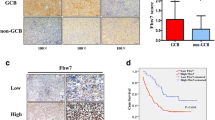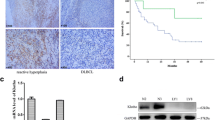Abstract
Background
Diffuse large B-cell lymphoma (DLBCL) is the most common subtype of non-Hodgkin’s lymphoma, which can involve various types of mature B-cells. Considering that the incidence of DLBCL has increased, additional research is required to identify novel and effective prognostic and therapeutic molecules. Fc receptor-like 1 (FCRL1) acts as an activation co-receptor of human B-cells. Aberrant expression of this molecule has been reported in a number of B-cell-related disorders. Moreover, the clinical significance and prognosis value of FCRL1 in DLBCL are not completely identified.
Methods
In this study, the expression levels of FCRL1 were determined in thirty patients with DLBCL and 15 healthy controls (HCs). In addition, the correlation between FCRL1 expressions with clinicopathological variables of DLBCL patients were examined. Then, the potential roles of FCRL1 in proliferation, apoptosis, and cell cycle distribution of B-cells from DLBCL patients were determined using flow cytometry analysis, after knockdown of this marker using retroviral short hairpin RNA interference. Quantitative real time-PCR, western blotting, and enzyme-linked immunosorbent assay were also used to identify the possible effects of FCRL1 knockdown on the expression levels of BCL-2, BID, BAX, intracellular signaling pathway PI3K/p-Akt, and p65 nuclear factor‐kappa B (NF-κB) in the B-cells of DLBCL.
Results
Statistical analysis revealed higher levels of FCRL1 expression in the B-cells of DLBCL patients compared to HCs at both protein and mRNA levels. A positive correlation was observed between the FCRL1 expression and some clinicopathological parameters of DLBCL patients. In addition, FCRL1 knockdown significantly decreased cell proliferation and stimulated apoptosis as well as G1 cell cycle arrest in the B-cells of DLBCL patients. The levels of p65 NF-κB and PI3K/p-Akt expressions were markedly reduced after knockdown of FCRL1 expression.
Conclusions
These results suggested that FCRL1 could be a potential novel biomarker for prognosis and/or a possible effective therapeutic target for treatment of patients with DLBCL.






Similar content being viewed by others
References
Bowzyk Al-Naeeb A, Ajithkumar T, Behan S, Hodson DJ (2018) Non-Hodgkin lymphoma. BMJ (Clin Res ed) 362:k3204. https://doi.org/10.1136/bmj.k3204
Susanibar-Adaniya S, Barta SK (2021) 2021 Update on Diffuse large B cell lymphoma: a review of current data and potential applications on risk stratification and management. Am J Hematol 96:617–629. https://doi.org/10.1002/ajh.26151
Chen B-J, Fend F, Campo E, Quintanilla-Martinez L (2019) Aggressive B-cell lymphomas: from morphology to molecular pathogenesis. Ann Lymphoma. https://doi.org/10.21037/aol.2018.12.02
Frick M, Dörken B, Lenz G (2011) The molecular biology of diffuse large B-cell lymphoma. Ther Adv Hematol 2:369–379. https://doi.org/10.1177/2040620711419001
Weber T, Schmitz R (2022) Molecular subgroups of diffuse large B cell lymphoma: biology and implications for clinical practice. Curr Oncol Rep 24:13–21. https://doi.org/10.1007/s11912-021-01155-2
Hunter E, McCord R, Ramadass AS et al (2020) Comparative molecular cell-of-origin classification of diffuse large B-cell lymphoma based on liquid and tissue biopsies. Transl Med Commun 5:5. https://doi.org/10.1186/s41231-020-00054-1
Mamgain G, Singh PK, Patra P et al (2022) Diffuse large B-cell lymphoma and new insights into its pathobiology and implication in treatment. J Fam Med Prim Care. https://doi.org/10.4103/jfmpc.jfmpc_2432_21
Epperla N, Vaughn JL, Othus M et al (2020) Recent survival trends in diffuse large B-cell lymphoma: have we made any progress beyond rituximab? Cancer Med 9:5519–5525. https://doi.org/10.1002/cam4.3237
Durmaz M, Visser O, Posthuma EFM et al (2022) Time trends in primary therapy and relative survival of diffuse large B-cell lymphoma by stage: a nationwide, population-based study in the Netherlands, 1989–2018. Blood Cancer J 12:38. https://doi.org/10.1038/s41408-022-00637-1
Sehn LH, Salles G (2021) Diffuse large B-Cell lymphoma. N Engl J Med 384:842–858. https://doi.org/10.1056/NEJMra2027612
Spinner MA, Advani RH (2022) Current frontline treatment of diffuse large B-Cell lymphoma. Oncology (Williston Park) 36:51–58. https://doi.org/10.46883/2022.25920940
Hatzivassiliou G, Miller I, Takizawa J et al (2001) IRTA1 and IRTA2, novel immunoglobulin superfamily receptors expressed in B cells and involved in chromosome 1q21 abnormalities in B cell malignancy. Immunity 14:277–289. https://doi.org/10.1016/S1074-7613(01)00109-1
Davis RS, Wang YH, Kubagawa H, Cooper MD (2001) Identification of a family of Fc receptor homologs with preferential B cell expression. Proc Natl Acad Sci USA 98:9772–9777. https://doi.org/10.1073/pnas.171308498
Davis RS (2007) Fc receptor-like molecules. Annu Rev Immunol 25:525–560. https://doi.org/10.1146/annurev.immunol.25.022106.141541
Rostamzadeh D, Kazemi T, Amirghofran Z, Shabani M (2018) Update on Fc Receptor-Like (FCRL) family: new immunoregulatory players in health and diseases. Expert Opin Ther Targets 22:487–502. https://doi.org/10.1080/14728222.2018.1472768
GGRA E, Leu C-M, Zhang S et al (2007) Fc receptor–like proteins (FCRL): immunomodulators of B cell function. Mechanisms of lymphocyte activation and immune regulation XI. Springer, New York, pp 155–162
Yousefi Z, Sharifzadeh S, Yar-Ahmadi V et al (2019) Fc receptor-like 1 as a promising target for immunotherapeutic interventions of B-cell-related disorders. Biomarker Insights 14:1177271919882351. https://doi.org/10.1177/1177271919882351
Rostamzadeh D, Dabbaghmanesh MH, Shabani M et al (2015) Expression profile of human Fc receptor-like 1, 2, and 4 molecules in peripheral blood mononuclear cells of patients with Hashimoto’s thyroiditis and graves’. Disease 47:693–698. https://doi.org/10.1055/s-0035-1545280
Yeo L, Lom H, Juarez M et al (2015) Expression of FcRL4 defines a pro-inflammatory, RANKL-producing B cell subset in rheumatoid arthritis. Ann Rheum Dis 74:928–935. https://doi.org/10.1136/annrheumdis-2013-204116
Baranov KO, Volkova OY, Mechetina LV et al (2012) Expression of human B-Cell specific receptor FCRL1 in healthy individuals and in patients with autoimmune diseases. Mol Biol 46:450–456. https://doi.org/10.1134/S0026893312020045
Wang K, Pei H, Huang B et al (2012) Overexpression of Fc receptor-like 1 associated with B-cell activation during hepatitis b virus infection. Braz J Med Biol Res 45:1112–1118. https://doi.org/10.1590/S0100-879X2012007500130
Portugal S, Tipton CM, Sohn H et al (2015) Malaria-associated atypical memory B cells exhibit markedly reduced B cell receptor signaling and effector function. Elife 4:e07218. https://doi.org/10.7554/eLife.07218.017
Capone M, Bryant JM, Sutkowski N, Haque A (2016) Fc receptor-like proteins in pathophysiology of B-cell disorder. J Clin Cell Immunol. https://doi.org/10.4172/2155-9899.1000427
Ise T, Nagata S, Kreitman RJ et al (2007) Elevation of soluble CD307 (IRTA2/FcRH5) protein in the blood and expression on malignant cells of patients with multiple myeloma, chronic lymphocytic leukemia, and mantle cell lymphoma. Leukemia 21:169. https://doi.org/10.1038/sj.leu.2404445
Falini B, Agostinelli C, Bigerna B et al (2012) IRTA1 is selectively expressed in nodal and extranodal marginal zone lymphomas. Histopathology 61:930–941. https://doi.org/10.1111/j.1365-2559.2012.04289.x
Li FJ, Ding S, Pan J et al (2008) FCRL2 expression predicts IGHV mutation status and clinical progression in chronic lymphocytic leukemia. Blood 112:179–187. https://doi.org/10.1182/blood-2008-01-131359
Polson AG, Zheng B, Elkins K et al (2006) Expression pattern of the human FcRH/IRTA receptors in normal tissue and in B-chronic lymphocytic leukemia. Int Immunol 18:1363–1373. https://doi.org/10.1093/intimm/dxl069
Du X, Nagata S, Ise T et al (2008) FCRL1 on chronic lymphocytic leukemia, hairy cell leukemia, and B-cell non-Hodgkin lymphoma as a target of immunotoxins. Blood 111:338–343. https://doi.org/10.1182/blood-2007-07-102350
Masir N, Jones M, Pozzobon M et al (2004) Expression pattern of FCRL (FREB, FcRX) in normal and neoplastic human B cells. Br J Haematol 127:335–343. https://doi.org/10.1111/j.1365-2141.2004.05193.x
Yousefi Z, Eskandari N (2019) Prognostic significance of Fc receptor-like 1 in patients with chronic lymphocytic leukemia, hairy cell leukemia, and various B-cell non-Hodgkin’s lymphoma. Leuk Res Rep 12:100181. https://doi.org/10.1016/j.lrr.2019.100181
Davis RS, Dennis G, Odom MR et al (2002) Fc receptor homologs: Newest members of a remarkably diverse Fc receptor gene family. Immunol Rev 190:123–136. https://doi.org/10.1034/j.1600-065X.2002.19009.x
DeLuca JM, Murphy MK, Wang X, Wilson TJ (2021) FCRL1 regulates B cell receptor-induced ERK activation through GRB2. J Immunol (Baltimore, MD: 1950) 207:2688–2698. https://doi.org/10.4049/jimmunol.2100218
Zhao X, Xie H, Zhao M et al (2019) Fc receptor-like 1 intrinsically recruits c-Abl to enhance B cell activation and function. Sci Adv 5:eaaw0315. https://doi.org/10.1126/sciadv.aaw0315
Leu C, Davis RS, Gartland LA et al (2017) FcRH1: an activation coreceptor on human B cells. Blood 105:1121–1127. https://doi.org/10.1182/blood-2004-06-2344
Vallangeon BD, Tyer C, Williams B, Lagoo AS (2016) Improved detection of diffuse large B-cell lymphoma by flow cytometric immunophenotyping: effect of tissue disaggregation method. Cytom B Clin Cytom 90:455–461. https://doi.org/10.1002/cyto.b.21322
Cunningham RE (2010) Tissue disaggregation. Immunocytochemical methods and protocols. Springer, New York, pp 327–330
Chang AY, Chau VW, Landas JA, Pang Y (2017) Preparation of calcium competent Escherichia coli and heat-shock transformation. JEMI Methods 1:22–25
Qureshi HY, Ahmad R, Zafarullah M (2008) High-efficiency transfection of nucleic acids by the modified calcium phosphate precipitation method in chondrocytes. Anal Biochem 382:138–140. https://doi.org/10.1016/j.ab.2008.07.027
Pfaffl MW, Horgan GW, Dempfle L (2002) Relative expression software tool (REST©) for group-wise comparison and statistical analysis of relative expression results in real-time PCR. Nucleic Acids Res 30:e36–e36. https://doi.org/10.1093/nar/30.9.e36
Pfaffl M (2009) Rest 2009 Software user guide. Qiagen, Hilden, Germany. https://www.gene-quantification.de/rest-2009.html
Frontzek F, Karsten I, Schmitz N, Lenz G (2022) Current options and future perspectives in the treatment of patients with relapsed/refractory diffuse large B-cell lymphoma. Ther Adv Hematol 13:20406207221103320. https://doi.org/10.1177/20406207221103321
Wang L, Li L, Young KH (2020) New agents and regimens for diffuse large B cell lymphoma. J Hematol Oncol 13:175. https://doi.org/10.1186/s13045-020-01011-z
Lam LT, Davis RE, Pierce J et al (2005) Small molecule inhibitors of IkappaB kinase are selectively toxic for subgroups of diffuse large B-cell lymphoma defined by gene expression profiling. Clin Cancer Res 11:28–40
Lam LT, Wright G, Davis RE et al (2008) Cooperative signaling through the signal transducer and activator of transcription 3 and nuclear factor- B pathways in subtypes of diffuse large B-cell lymphoma. Cytokine 111:3701–3713. https://doi.org/10.1182/blood-2007-09-111948.The
Lodhi N, Tun M, Nagpal P et al (2020) Biomarkers and novel therapeutic approaches for diffuse large B-cell lymphoma in the era of precision medicine. Oncotarget 11:4045–4073. https://doi.org/10.18632/oncotarget.27785
Bai D, Ueno L, Vogt P (2009) Akt-mediated regulation of NFkB for the oncogenicity of PI3K and Akt. Int J Cancer 125:2863–2870. https://doi.org/10.1002/ijc.24748.Akt-mediated
Davis RE, Brown KD, Siebenlist U, Staudt LM (2001) Constitutive nuclear factor kappaB activity is required for survival of activated B cell-like diffuse large B cell lymphoma cells. J Exp Med 194:1861–1874. https://doi.org/10.1084/jem.194.12.1861
Schatz JH (2011) Targeting the PI3K/AKT/mTOR pathway in non-Hodgkin’s lymphoma: results, biology, and development strategies. Curr Oncol Rep 13:398–406. https://doi.org/10.1007/s11912-011-0187-7
Staff PONE (2014) Correction: cross-talk between NFkB and the PI3-Kinase/AKT pathway can be targeted in primary effusion lymphoma (PEL) cell lines for efficient apoptosis. PLoS ONE 9:e92484. https://doi.org/10.1371/journal.pone.0092484
Pavan A, Spina M, Canzonieri V et al (2008) Recent prognostic factors in diffuse large B-cell lymphoma indicate NF-κB pathway as a target for new therapeutic strategies. Leuk Lymphoma 49:2048–2058. https://doi.org/10.1080/10428190802444176
Wang J, Xu-Monette ZY, Jabbar KJ et al (2017) AKT hyperactivation and the potential of AKT-targeted therapy in diffuse large B-cell lymphoma. Am J Pathol 187:1700–1716. https://doi.org/10.1016/j.ajpath.2017.04.009
Acknowledgements
The present study was supported by Isfahan University of Medical Sciences as a PhD Thesis.
Funding
This study was funded by Isfahan University of Medical Sciences (grant number: 394608).
Author information
Authors and Affiliations
Corresponding author
Ethics declarations
Conflict of interest
The authors declare that there is no conflict of interests.
Ethical approval
All procedures performed in this study were in accordance with the ethical standards outlined by the ethics committee of Isfahan University of Medical Sciences (ID: IR.MUI.REC.1394.3.608) as well as the 1964 Helsinki Declaration and its later amendments or comparable ethical standards.
Informed consent
Written informed consent was obtained from all the participants included in the study.
Additional information
Publisher's Note
Springer Nature remains neutral with regard to jurisdictional claims in published maps and institutional affiliations.
Supplementary Information
Below is the link to the electronic supplementary material.
11033_2022_8104_MOESM1_ESM.jpg
Supplementary material 1 (JPG 116 kb). Supplementary Fig. 1. Gating strategy and flow cytometric analysis of FCRL1 protein expression (A) in B-cells of one healthy individual (B) and malignant/ lymphoma B-cells of one patients with DLBCL
Rights and permissions
Springer Nature or its licensor (e.g. a society or other partner) holds exclusive rights to this article under a publishing agreement with the author(s) or other rightsholder(s); author self-archiving of the accepted manuscript version of this article is solely governed by the terms of such publishing agreement and applicable law.
About this article
Cite this article
Yousefi, Z., Sharifzadeh, S., Zare, F. et al. Fc receptor-like 1 (FCRL1) is a novel biomarker for prognosis and a possible therapeutic target in diffuse large B-cell lymphoma. Mol Biol Rep 50, 1133–1145 (2023). https://doi.org/10.1007/s11033-022-08104-7
Received:
Accepted:
Published:
Issue Date:
DOI: https://doi.org/10.1007/s11033-022-08104-7




